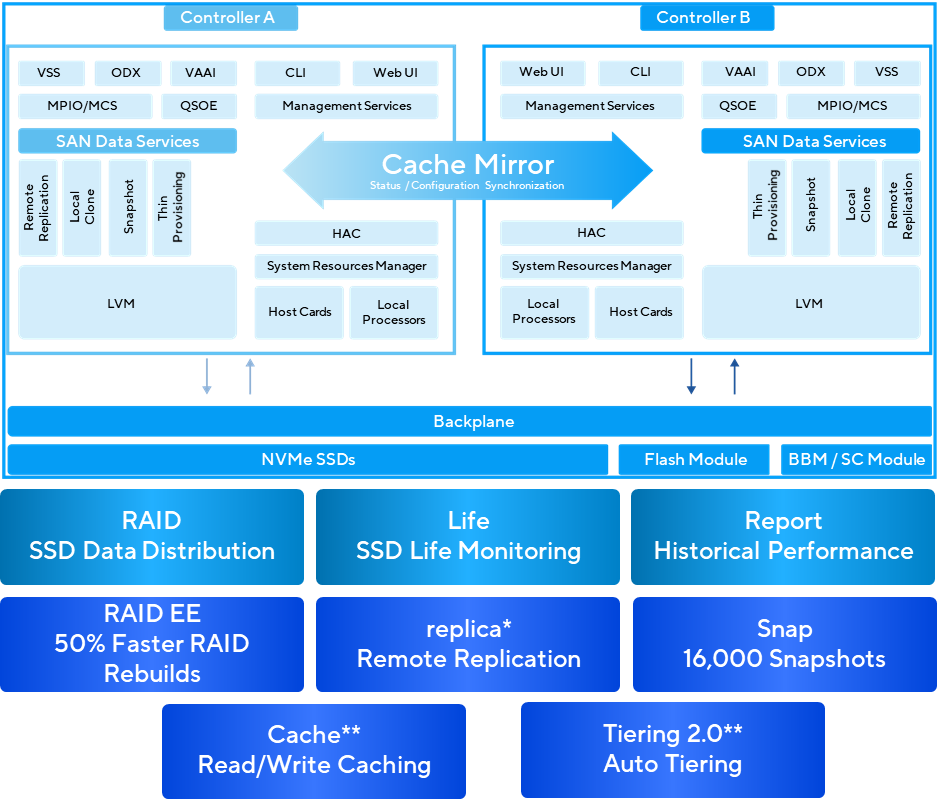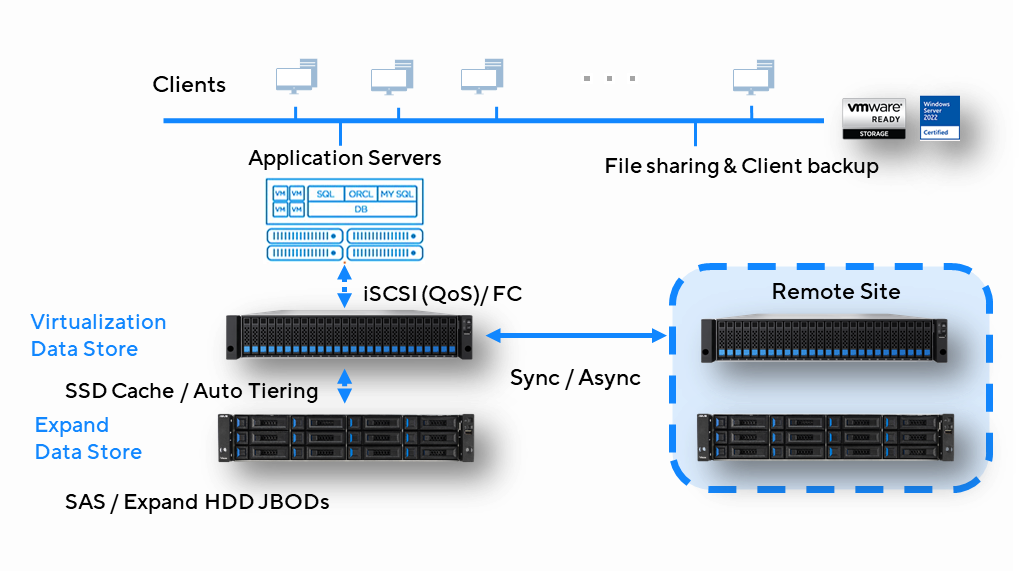Oct 25, 2024
Enhancing IT Infrastructure Efficiency and Flexibility through Integrated SAN Storage and Virtualization
As businesses increasingly depend on information technology, improving infrastructure efficiency and flexibility with limited resources has become a core challenge for IT managers. ASUS Storage Area Network (SAN) and virtualization solutions transform how companies manage computing and storage resources, offering unparalleled advantages in terms of cost management, scalability, and performance. These solutions are key components of modern data centers.
This article details how virtualization platforms integrate with the ASUS SAN (VS320D-RS26) solution, highlighting specific benefits such as simplified management, improved performance, and enhanced flexibility. Solutions to typical challenges encountered during the integration process are also discussed.
ASUS VS320D Series
The ASUS VS320D series (VS320D-RS26; VS320D-RS12) is a dual-controller shared storage system that connects to servers via high-speed dedicated networks. Operating in a dual-active mode, it provides better I/O performance and high availability. The VS320D offers 16Gbps and 32Gbps Fibre Channel or built-in 10G or 25G Ethernet connections, and it uses FC and iSCSI protocols for data access.
Traditional storage architectures often rely on Direct-Attached Storage (DAS) or server-based local storage, where each server has its storage device. However, these setups suffer from poor scalability, complex management, and performance bottlenecks. In contrast, the VS320D centralizes storage resources, allowing multiple servers to share the same storage pool, simplifying storage management and improving resource utilization.

The Rise of Virtualization Platforms
The core concept of virtualization platforms is abstracting hardware resources so that multiple virtual environments can share them. ASUS servers with virtualization platforms allow multiple virtual machines (VMs) to run on a single server, with each VM having its operating system and applications. Virtualization platforms enable businesses to use hardware resources efficiently while dynamically allocating resources based on demand, improving operational efficiency and reducing costs.
Another major advantage of virtualization is increased business flexibility. When businesses need to expand their computing or storage capacity, they can create or extend existing virtual machines without purchasing additional hardware.
Benefits of Integrating Virtualization Platforms with the ASUS VS320D
Virtualization platforms allow multiple virtual machines to share the same hardware, and the ASUS SAN solution enhances this by enabling all VMs to access the same storage resource pool. This improves resource utilization, ensures data consistency, and allows dynamic allocation of storage resources. Additionally, the ASUS VS320D supports container CSI services, meeting various storage needs at the application level.
Access control and data isolation between VMs are managed effectively using ASUS storage block technology, ensuring efficient data access even in multi-tenant environments.
High Availability and Disaster Recovery

Integrating virtualization with the VS320D significantly enhances system availability. In virtualized environments, platforms such as VMware vSphere, Microsoft Hyper-V, and Proxmox provide high-availability features, enabling the rapid migration of failed virtual machines to other running servers without business interruption. The VS320D offers centralized data management, allowing quick I/O path switching after failures, and its Remote Replication technology facilitates fast recovery of storage services in the event of a disaster. Snapshot technology can also quickly restore corrupted or compromised data after malicious attacks, deletions, or ransomware incidents.
Furthermore, the VS320D supports multipath I/O, allowing virtual machines to access multiple data paths. This ensures continuous data access, even if a physical device or network experiences failure, making it vital for businesses that require high availability and business continuity.
Simplified Management
In environments where virtualization platforms and the VS320D are integrated, businesses can more easily manage their infrastructure. Modern virtualization platforms come with powerful management tools, enabling administrators to manage entire VM clusters from a single console. Meanwhile, ASUS SAN storage simplifies configuration and monitoring through centralized storage management tools.
Scalability and Flexibility
The VS320D offers excellent scalability. As businesses grow, so do their storage needs, and ASUS storage can expand via SAS JBODs, offering up to 10PB of available space without requiring major changes to the existing infrastructure. When integrated with virtualization platforms, expanding storage or computing resources becomes even simpler—businesses can easily add new VMs and allocate the necessary storage resources.
Challenges in the Integration Process
Cost
SAN systems using Fibre Channel architecture can meet low-latency requirements but come at more cost, which can be a barrier for small and medium-sized businesses. iSCSI is a more affordable option that uses standard Ethernet networks. Additionally, setting up Fibre Channel networks typically requires specialized technical expertise, which can further increase operational costs.
Performance Bottlenecks
As the number of virtual machines increase, storage performance demands rise accordingly. Without proper planning for scalability, businesses may face performance bottlenecks that affect overall system efficiency. However, ASUS VS320D supports read/write caching and auto tiering, leveraging SSDs to accelerate I/O performance and meet the I/O needs of enterprise applications. Selecting the right storage and network architecture is crucial for performance.
Technical Complexity
Integrating virtualization technology with ASUS storage, especially optimizing I/O paths and data cache, requires a skilled technical team with strong knowledge of networking, storage, and virtualization. Businesses can rely on a professional SI provider or ASUS expert services to manage the integration process and avoid risks associated with technical difficulties. Below please find V320D & Virtualization Infrastructure as reference.

Conclusion
As data demands for businesses continue to grow, the integration of virtualization technology with ASUS storage is an essential solution for modernizing data centers. This integration not only improves resource utilization but also enhances system availability and flexibility. However, careful planning is necessary to address costs and technical challenges. With a well-designed integration strategy, combining virtualization and ASUS storage will provide any business with a more competitive IT infrastructure, helping them stay ahead in an increasingly digital marketplace.



